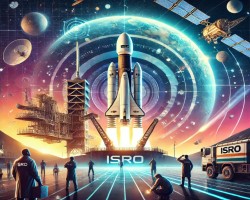UPSC Current Affairs
| Science and Technology |
|---|
|
|
|
Why in the News?
The Indian Space Research Organisation (ISRO) is set to achieve a significant milestone with its 100th launch from the Satish Dhawan Space Centre in Sriharikota. Scheduled for January 29, the launch will deploy the GSLV-F15 NVS-02 mission, marking another step forward in India’s space and navigation advancements. Key Takeaways: Mission Overview: The GSLV-F15 will place the NVS-02 satellite into a Geosynchronous Transfer Orbit, enhancing India's regional navigation system, NavIC (Navigation with Indian Constellation). Satellite Details: NVS-02, part of the second-generation NavIC satellites, incorporates advanced navigation payloads in L1, L5, and S bands and features both indigenous and procured atomic clocks for precise timekeeping. Strategic Importance: NavIC is India’s independent navigation system designed for accurate Position, Velocity, and Timing (PVT) services across the country and up to 1,500 km beyond its borders, ensuring strategic self-reliance in navigation. Do You Know? NavIC provides two services: the Standard Positioning Service (SPS) for civilian use and the Restricted Service (RS) for strategic users. With an accuracy of better than 20 metres for positioning and better than 40 nanoseconds for timing, NavIC ensures reliable navigation services in its primary coverage area. The NVS-01 satellite, launched in May 2023, was the first to feature an indigenous atomic clock, highlighting India’s growing technological capabilities. Static Points about ISRO Missions: The GSLV-F15 mission will launch from the second launch pad at the Satish Dhawan Space Centre, emphasizing ISRO's operational expertise. The NVS-02 satellite, designed on the I-2K platform with a mass of 2,250 kg, will replace the IRNSS-1E satellite at 111.75°E. ISRO’s U. R. Satellite Centre (URSC) spearheaded the design and development of NVS-02, showcasing India's strong ecosystem of space research and collaboration. Conclusion: ISRO’s 100th launch not only marks a historic milestone but also highlights India’s relentless strides in space technology and self-reliant navigation systems. With the NVS-02 satellite, NavIC continues to strengthen its strategic and civilian services, reinforcing India’s position as a key player in the global space arena. |
|
|
|
About Indian Space Research Organisation (ISRO):
Formed: 15 August 1969 Preceding agency: INCOSPAR (1962–1969) Headquarters: Bengaluru, Karnataka Chairman: V Narayanan (11th Chairman of the Indian Space Research Organisation) Primary spaceports: Satish Dhawan Space Centre, Thumba Equatorial Rocket Launching Station, Kulasekarapattinam Spaceport |
| >> More UPSC Current Affairs |
